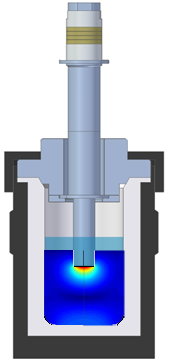Interaction of ultrasonic transducer and fluid in cavitation-based processes
Ultrasound is applied to improve various chemical processes. The operating parameters for the ultrasound equipment are usually determined empirically, as the interaction between sound field and ultrasound transducer has not yet been studied systematically and there is no method for measuring cavitation activity without applying additional sensors.
Based on a detailed experimental investigation of a sonochemical reactor Dr.-Ing. Peter Bornmann during his PhD set up a Finite-Element-Model, that considers the interaction between the ultrasound transducer and the sound field. The model-based analysis of the sonochemical reactor shows, that due to the acoustical characteristics of the autoclave, cavitation only occurs close to the tip of the sonotrode. The interaction between sound field and ultrasound transducer allows to obtain information about the sound field and the cavitation activity based on the feedback on the driving signals of the ultrasound transducer. Furthermore, the calculated sound field is suitable to predict the occurrence of cavitation. The presented model provides important information for the design, analysis and scale-up of sonochemical reactors.
Due to the harsh process environment in many sonochemical processes the application of sensors to monitor the cavitation activity is not possible. For this purpose, a method for online cavitation measurements was developed, that is based on the feedback of cavitation events on the driving signals of the ultrasound transducer. This method enables to perform sonochemical reactions predictable and reproducible and is an important progress for existing and to be developed ultrasound equipment for cavitation-based processes.
The PhD thesis of Dr. Bornmann is available here.
His Publications are listed here.



